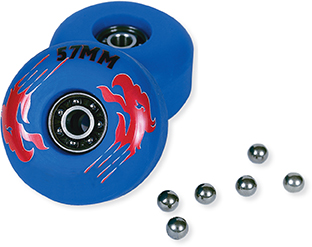Quick Lab
Observing the Effects of Friction
Procedure
Attach a sticky note to the widest side of a rectangular eraser. The note must cover the entire side of the eraser. Trim off excess paper with scissors.
Place the eraser from Step 1 note-side down, next to a second eraser so that one end of each eraser extends 2 cm over the edge of a table.
Use a ruler to strike both erasers firmly and evenly at the same time. Record the distance each eraser slides.
Repeat Steps 2 and 3 two more times. Calculate and record the average distance each eraser slides.
Analyze and Conclude
Observing Which eraser slid farther?
Formulating Hypotheses Why did the erasers slide different distances?
Drawing Conclusions How does friction affect the motion of a sliding object?
Revising What could you do to make the erasers slide even farther?
Rolling Friction
When a round object rolls across a flat floor, both the object and the floor are bent slightly out of shape. This change in shape at the point of rolling contact is the cause of rolling friction, the friction force that acts on rolling objects. For a given set of materials, the force of rolling friction is about 100 to 1000 times less than the force of static or sliding friction. Because of this, professional movers often use wheeled dollies to move heavy objects.
Ball bearings like those shown in Figure 6 are often used to reduce friction in machines. A ball bearing is made up of a set of round balls located between two smooth surfaces. The balls roll as the surfaces move past each other. Friction is greatly reduced between the surfaces because rolling friction replaces sliding friction. Inline skates, skateboards, bicycles, and automobiles are just a few of the many machines that use ball bearings.
Fluid Friction
Friction also acts on a submarine moving through water and on an airplane flying through air. Water and a mixture of gases such as air are known as fluids. The force of fluid friction opposes the motion of an object through a fluid. You feel fluid friction when stirring thick cake batter. The motion of the spoon through the batter is slowed by fluid friction. Fluid friction increases as the speed of the object moving through the fluid increases. Thus the faster you stir, the greater the friction is.
Fluid friction acting on an object moving through the air is known as air resistance. At higher speeds, air resistance can become a significant force. For this reason, bicyclists and speed skaters often wear slick racing suits to reduce air resistance.

What are two common examples of fluid friction?

Figure 6 Ball bearings in these wheels greatly reduce friction by replacing sliding friction with rolling friction.




